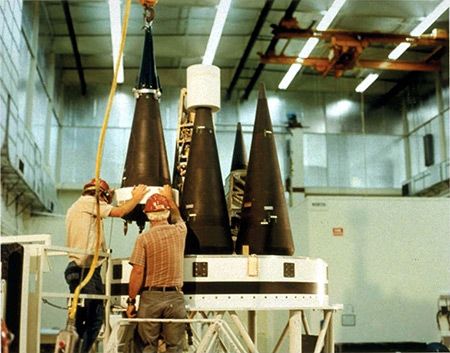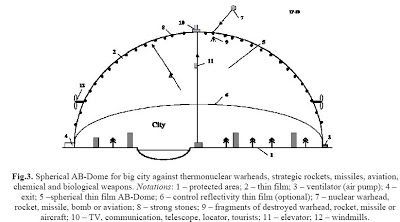1. Language and cultural isolation lead to the situation then Russian researches are not known in West and vice versa. I spent a lot of time translating into Russian and promoting works of Bostrom, Yudkowsky, Circovic, D.Brin, Freitas, A.Kent and other writers on global risks. Here I would like to tell you about some Russian researchers. Though I can’t prove validity of their ideas I think they should be checked internationally in order to roll out them or to take preventive measures. A. V. Karnauhov created a theory of “green house” catastrophe. He shows that climate is non linear system this many positive feedbacks and one of them is often missed – it is that water vapor is also greenhouse gas and growing temperatures would lead to injection of more and more water vapor into atmosphere. Also current level of carbon dioxid should lead to much more temperature increase, but inertia of ocean temperature makes current temperature smaller. But ocean temperature will rise, especially in Arctic, where large amounts of methane stored under seebed on the low shallow waters. This would lead to clarhat gun explosion of metane. Cumulative effect of water vapor, CO2, Metane and surmounting of ocean inertia will lead to very quick exponential global warming, which could have devastating effects as early as in 2020th and make global temperature higher not on 6 degrees but on several tens to the end of the century – which would mean human extinction, and after 200 years all life extinction on Earth Some his ideas you could see in the article: http://www.poteplenie.ru/doc/role.pdf Karnaukhov A.V. Role of the biosphere in the formation of the Earth’s Climate: The Greenhouse Catastrophe, Biophysics, Vol.46, No 6, 2001, pp. 1078–1088. Also I should mention works of Drobishevsky “Danger of the explosion of Callisto and the priority of space missions” http://www.springerlink.com/content/584mw0407824nt72/ He thinks that Jovian satellite Callisto could soon explode because of H and O reaction in its ice. Such explosion will lead to bombardment of the earth by comets and “nuclear winter” for 60 years. He suggested to send there a space mission. But I wrote him that, if he is write, it is very dangerous to send where mission, because it could trigger the explosion by drilling the ice crust. And the last man, about whom I would like to tell you, is a reviewer of my book “the Structure of the global catastrophe” Aranowich, who told me by way that his group has created much more effective way to penetrate the earth crust the Stevenson’s probe. Stevenson’s probe require 10 million ton of melted iron. His probe will weight only 10 tons and will use an energy of radioactive decay. It could reach 1000 km depth by one month – and the main danger is creation of supervolcano. Then I asked him, was any safety analysis done – he said not. But this is only theoretical work and no practical realization is planned.
2. I have wrote a book “The structure of global catastrophe” which aim was to investigate how different scenarios of global risks could interact in time, because all of them could realize in the XXI century. This book is sponsored by Russian Transhumanist movemet. Nick Bostrom wrote short preface to it. The book is mostly ready, but some editorial and organizational problems still persists. I hope it will be published by the end of the year.
3. I am started to translate this book into English. I have translated it by computer and then edit the result – now I am on the page 27 of 390. I need someone with native English who could help me to edit this translation. The book is here: http://avturchin.narod.ru/sgkengl2.doc I hope to finish English translation (in readable, but not high literature quality:) of the book until winter.
4. The shorter version of this book is already published on the name “War and 25 other scenarios of the End of the world”. This name was suggested by editorial house, the original name was: “Gnoseology of catastrophes”. The main idea of the book is that our inability to predict the future is equal to the end of the world.
5. I have translated the most part of Lifeboat site on Russian and I expect it will appear in the Net soon.
6. I have wrote several articles on the theme of global catastrophe: “Is SETI dangerous? English translation — http://www.proza.ru/texts/2008/04/12/55.html, “Atrophic principle and natural catastrophes” http://www.proza.ru/texts/2007/04/12-13.html and “About possibilities of manmade ignition of giant planets and other objects of Solar system” http://www.proza.ru/texts/2008/07/19/466.html which are in Russian.
7. I have created “Global catastrophic risks and human extinction library” there you could find many interesting literature on English and Russian. http://avturchin.narod.ru/Global.htm
8. I think that it is provable that if humanity will unite, it will have a chance to resist global risks, but if it will be divided on military competing parts, it almost doomed. Resent events on Caucasus put again in agenda the question of New cold war. Here we should ask what is the worst outcome of possible Cold war? Common answer is that Nuclear war is that worst outcome. But Nuclear war will not terminate all human population in most realistic scenarios. Much worse outcome is, I think, new arm race, which could lead to quick creation of much more destructive weapons, than nuclear. And the worst outcome of arm race is creation of Doomsday machine. Doomsday machine (DM) is ultimate defense weaponry. The example of such strategy was depicted by Kubrick in his genius movie “Dr. Strangelove”. Here we should say that DM-strategy is more suitable for a weaker state, which is in danger of aggression (or feels so). Quality of Russian nuclear forces is continue to deteriorating and minimum is expected around the year 2010 then most of old soviets rockets should be out of order. Simultaneously after the year 2010 US will rich a peak of their supremacy (because of thousand non nuclear cruise missiles, unique GPS system and antimissile shield it will have ability to make first strike without answer.), but later could lose supremacy because of economic crisis in US and growing arsenal of new Russian missiles. This situation looks dangerous, because from chess we know the principle: “Someone must attack under threat of losing his supremacy”. And antiballistic missile shield (ABM), which is developing now by NATO is very dangerous because it makes direct way to the creation of Doomsday Machine. Before ABM rockets were good as a mean of defense. But now only large underground bomb (gigaton order and with cobalt shield) could be a strategic defense. Such ideas is not only my creation but they are circulating in the air. Of course nobody is going to actually use such weapon, but it could be lunched accidentally. It should not be nuclear – it could be also large stockpile of anthrax, manmade supervulcano-threat or something more sophisticated. DM also could be used as a offensive mean. If Osama get it, he could say: everybody should convert in Islam, or I detonate it. The really big problem arise if in answer someone Catholic say: if anyone convert in Islam I will detonate my own Doomsday machine. In this case we finally doomed. But worst case scenarios are low probability ones, so I hope we have a chance to unite.

 I wrote an essay on the theme of the possibility of artificial initiation and fusion explosion of giants planets and other objects of Solar system. It is not a scientific article, but an atempt to collect all nesessary information about this existential risk. I conclude that it could not be ruled out as technical possibility, and could be made later as act of space war, which could clean entire Solar system.
I wrote an essay on the theme of the possibility of artificial initiation and fusion explosion of giants planets and other objects of Solar system. It is not a scientific article, but an atempt to collect all nesessary information about this existential risk. I conclude that it could not be ruled out as technical possibility, and could be made later as act of space war, which could clean entire Solar system.









